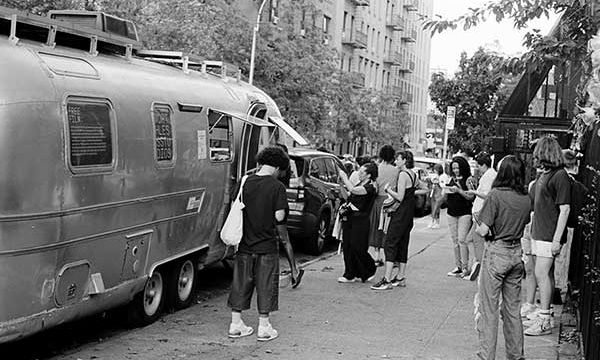Worthless Studios encourages residents of the South Bronx to take photos of their area with old-school film cameras
Carlos de la Sancha
For the past year, a shiny, silver Airstream trailer has been parked for a month at a time in different neighbourhoods across New York, distributing rolls of 35mm film for free and serving as a darkroom for resident photographers.
The mobile photo lab is an ongoing project by the Brooklyn-based art space Worthless Studios, with previous iterations travelling across the US. Free Film: NYC, as this edition is called, has so far made stops in Red Hook, the Lower East Side and the South Bronx, with the Airstream due to roll into Green-Wood Cemetery in Sunset Park, Brooklyn, this month and the Brotherhood of Sister Sol youth centre in Harlem in November.
At a time when the world is inundated with digital photography, and images generated using artificial intelligence are raising questions about authenticity and authorship, the Free Film project marks a return to a more physical form of the medium.
“Analogue has made a comeback,” says Neil Hamamoto, the founder and artistic director of Worthless Studios. There is a strong community of photographers who still shoot on film, he adds, and others who have held onto their manual cameras and remember the basics. “It’s something about the medium that just always sticks with people,” he says. “We’ve seen folks come in who just love the smell of the darkroom and love to sit down and share stories about their time learning photography.”
The project hands out between 100 and 150 rolls of film at each location and asks recipients to capture images based on a specific prompt. For the New York edition, the theme is One Square Mile, and neighbourhood boundaries are mapped out for participants, but they can otherwise interpret the theme as they wish.
At the end of the month, participants can return their film to the trailer and have it developed without charge, receiving free scans of their images from Worthless Studios. About 75% of the rolls are returned, Hamamoto says. “We try to vet people that we think will take the project seriously,” he adds, “and in certain instances, we are able to loan cameras to those that really want to participate.”
Worthless Studios partners with community organisations to host the Airstream, such as the Bronx Documentary Center and the Lower East Side Girls Club, and a resident photographer heads the project in each neighbourhood, leading classes and workshops, or taking groups on photo walks. Resident photographers get a $2,500 stipend as well as the materials they need to develop their own film and make prints. “Part of our mission is to provide resources to young career artists,” Hamamoto says, “handing over a set of keys for them to do what they want with the darkroom space.”
Sofie Vasquez, the resident photographer during the project’s stint in the South Bronx, says her focus was accessibility, opening the Airstream’s darkroom to photographers who never had the chance to create their own prints or experiment with techniques like cyanotype. “I like learning new things, especially with photography,” Vazquez says. “And I think just giving people access to knowledge and options, that’s how someone’s going to naturally figure out what they want to create.”
On Free Film’s opening day in the South Bronx, photographers of all experience levels stopped by the trailer, from a first-time manual camera user joining his friend who had recently taken up the medium, to emerging artists who had participated in other legs of the project.
A selection of 100 to 200 images drawn from the thousands submitted will be displayed in an exhibition at Worthless Studios’ space in East Williamsburg next year, where the project will end its tour. A book of photographs will also be published.
Despite the variety of people taking part in the project, some common themes are already emerging, Hamamoto says, such as portraits of passersby taken on the street. This shows the connections that photography can make. “Trying to take a photograph of someone sparks conversation,” he says, “and joy.”

